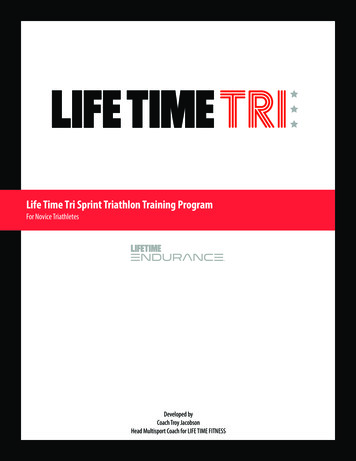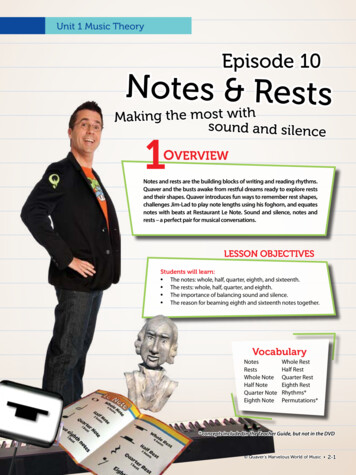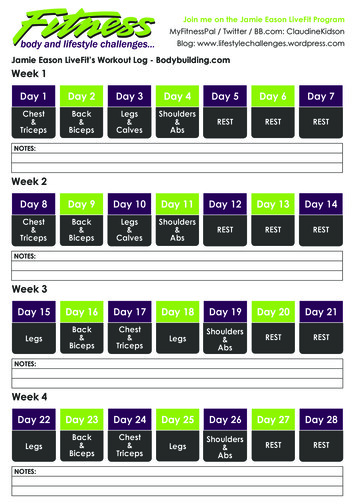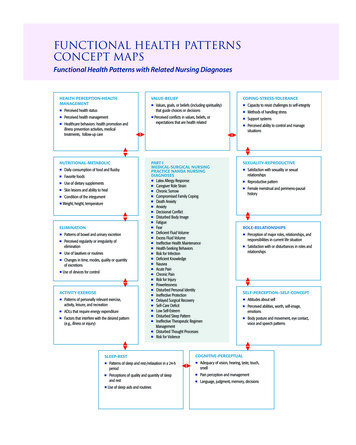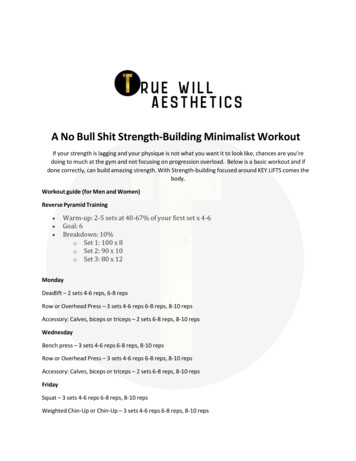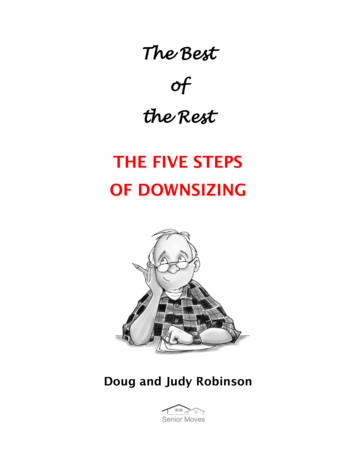
Transcription
The Bestofthe RestTHE FIVE STEPSOF DOWNSIZINGDoug and Judy Robinson
This e-book is part of a series and contains expanded advice, wisdomand experiences from the book:The Best of the Rest:Downsizing for Boomers and Seniors(2010)All e-books in the series:Downsizing: Lots of ChoicesThe Five Steps of DownsizingAging in PlaceChoosing a Retirement Residence or a Nursing HomeMulti-Generational HouseholdsSelling Your HomeLuxury Living on WheelsSailing Off Into the SunsetAll publications by Doug and Judy ngforboomersandseniors@gmail.com
Cover graphic: Gary FrederickCopyright Doug and Judy Robinson 2015All rights reserved. No part of this book may be reproduced, stored in orintroduced into a retrieval system, or transmitted, in any form or by any means(electronic, mechanical, photocopying, recording or otherwise) without the priorwritten permission of the publisher. Requests for permission should be directed toinfo@seniormoves.ca or mailed to Permissions, Senior Moves, 1554 CarlingAvenue, Box 40, Ottawa, Ontario, Canada K1Z 7M4.ISBN 978-0-9948631-3-3 (ebook)
The Five Steps of Downsizing is dedicatedto our children, Mike, Sue, Andrewand their families,including ten wonderful grandchildren.
AcknowledgmentsThanks to our team at Senior Moves who have believed in us,encouraged us and enabled us to work on these books,especially Janet Villeneuve, Trish Morin and Nancy Perkins.Thanks to Susan Rothery for her wisdom, experience and knowledgein helping see this e-book to completion.Thanks to Tamara Lowe and her team at Kingdom Builders Academywho made an impossible dream a reality.Thanks also to Angela Sutcliffe and Barbara Munshawwho have taken us from retired seniorsto successful business owners and writers.
IntroductionTHE PURPOSE OF THIS BOOK is to help you consider your options,organize your thoughts and ask questions before making any decisions orcommitments about downsizing. Our goal is to provide you with information thatcan help you make your own more informed decisions. Whatever the choice, yourgoal is to have the best quality of life possible.Please note that we are not providing legal advice. Given that laws varyfrom region to region concerning tax matters, real estate practices, elder care,estate organization and settlement, we strongly recommend that you consult theappropriate professional resource to advise you on your own situation, whereapplicable.
The Five Steps ofDownsizing(Including"What to Do With My Stuff?")MANY PEOPLE EITHER WANT to move or know that they should. Buttheir "stuff" is one enormous roadblock. They have things they have collected,things they have stored for others, things that were broken that they planned torepair, things they might "need" someday, things they feel have value, andtreasures that "should" stay in the family. Stuff can be a big roadblock tomoving on with your life!Most people are extremely anxious about what to do with their "stuff."Women frequently get bogged down because so many things are associated withprecious memories, yet they simply can't keep everything. They can usually tellyou a story about each item and are reluctant to part with any of them. Children, onthe other hand, tend to have more of a simplistic agenda that comes to a screaminghalt when Mom starts sorting her treasures, trying to decide what to bring.Two impatient sons were urging their mom to make quick decisions onthings she would like to keep and bring to her new home. You could literally seethe anxiety building up in her eyes and facial expressions. Glaring at her boys, shetook a deep breath and snapped, "What if I had to decide between the two of you?"
The sons got the message, backed off, and took a more patient attitude toward theirmom's "lifetime treasures."Conversely, many men will simply say, "Shovel it out and send me the bill!"One gentleman had five university degrees and discarded all of the diplomas. Hesaid, "They are of no use to me now."Some men, on the other hand, do have difficulty dealing with memorabiliaand other manly treasures.I was with three different women one day who all needed HUGS. One wasin her seventies, living in their dream home when her husband had a bad accidentand ended up in a nursing home. She felt she should sell her large home and moveon. On the day before the move she was in tears, feeling she had made a bigmistake. We reassured her that many people have the same reaction and she hadmade a wise decision. Knowing she was bringing many of her "treasures" with heralso proved to be very comforting.The second occasion was with a daughter standing in a "tired" home that shehad grown up in. She lived thousands of miles away and lamented that she didn'thave the money to buy the house of her childhood and "fix it up." Finally, shecompensated by keeping one chair and three boxes of "treasures" that could bestored easily in a friend's basement.The third hug went to a widow who was ninety-five years old. One minuteshe felt she should move and the next she was determined to stay. Everything had amemory, including the forty or fifty empty wine bottles.Many people who are considering downsizing are storing things for familymembers or friends. Contact them, tell them what you are doing and ask them toremove their items within a month or allow you to dispose of them.FIVE STEPS OF DOWNSIZING1. What to keep2. What to give to family or friends3. What to sell
4. What to donate5. What to discard1. WHAT TO KEEPAlthough we encourage each person to keep what is really important, thevery nature of downsizing dictates that some tough decisions need to be made. Wehave seen some people keep way too much, making it a very long, expensive andfrustrating experience for everyone on moving day as they try to shoehorn it all in.We usually ask people how they want to live in their new "home." Thishelps them decide what they want to keep.Remember that when you are downsizing, spaces are usually smaller andlarge bedroom sets, sofas and big dining room sets simply won't fit.An important first step in deciding what to keep is to take a careful look atthe new residence and see what will fit. Look at windows, wall plugs, lightswitches, heating, and thermostat locations. Once there is an understanding of theavailable space, it will help with many critical decisions.Often people make a list of what to keep. This is a great start, but over theyears we have found a much more effective process that provides visible remindersof things to keep as well as a certain level of comfort: COLOREDREMOVABLE DOTS. They are a useful tool for anyone who is downsizing.Placing the color-coded dots on things provides a level of reassurance to peoplewhile reducing the risk of discarding "treasures." For those with memory loss, thedots are a great comfort. They are less confused when they can look around a roomand quickly identify what will be coming with them. For seniors, we often useGREEN – Green is go! It will be going with them to their new home.TIP: Try to identify the items you are keeping before the extendedfamily arrives to see what they would like. If there is a green dot, the item is notnegotiable and moves with you or the senior.Judy is a mom and grandma. If one of our children were to say, "I've alwaysloved that picture," she would give it to him or her even if it were the item she
valued most and had planned to bring it with her. Her dot on it says "NO!" beforeanyone even asks.Later, family members can use different colors to identify what will be givento others, sold or donated to charities. The last decision is easy: discard the rest!The dots provide clarification for family members and loved ones that can oftenhelp prevent misunderstandings or conflicts. Remember, the last thing anyoneneeds during this time is unnecessary "problems."If you are relocating far away, check out the cost of moving your furniture.Some people move only their "treasures" and purchase new or gently-usedfurniture when they arrive because moving costs could be prohibitive. Some buyretirement homes or mobile homes that are already furnished and replace the itemsthey don't like. The surplus can be sold or given away.NOTE TO ADULT CHILDREN: If you are working with parents, try tomake them feel that they have some control in the decision-making process. Itkeeps them in their comfort zone and helps them to be generally more content withtheir new home. You can help them by saying something like, "There is room forthree chairs. Which three would you like to bring?" Narrowing down the decisionsfor them is helpful, but make sure it is based on an understanding of what is reallyimportant to them.Seniors want to bring specific things for a reason. Often we don't takethe time to listen to their "WHY!"One lady wanted to bring an old curio cabinet. She explained that she hadspent a lot of time in her grandmother's home as a child and this antique was a bigpart of her wonderful memories there. We made room for it.Another lady wanted to bring her bed and her sofa-bed to a single room soher sister could visit her once or twice a year. Her elderly brothers were trying toconvince her to leave the sofa-bed, based on the limited space she was moving to.As the family looked on with furrowed brows, Judy said, "The sofa-bed willfit OR you could bring your china cabinet. Of course if you brought the cabinet,you could also bring some notepaper and your beautiful cups and saucers, as wellas your knick-knacks "
"I'll bring my china cabinet," she declared with a distinct look ofsatisfaction. (This is an example of a non-confrontational approach especiallyhelpful for people with Alzheimer's that allows them to participate and, in somecases, feel they are still 100 percent in charge.)Although this can be an exciting time for fifty and sixty year olds who arelooking at a new life style, for seniors it can be very difficult for them and theirfamily members. Familiar, sentimental belongings are very important in makingthe new residence fell more comfortable. Remember, "Home is where your stuffis!" Also, whether you are young or old, if you get rid of something sentimental orvaluable, you usually can't get it back.Bring the things that are important to you or your parent. If the dailyroutine involves taking a nap on the sofa, see if you can work it in. If books areimportant, bring a bookcase, comfortable chair and a good reading lamp. We havemoved many people with Alzheimer's who no longer read, yet books are stillimportant to them. Books are their "friends." Instead of saying, "Dad, you nolonger read," say, "Books have always been important to you. Let's choose a fewand make a place for them."When gardening is important, bring some plants, a watering can and evensome plant food. Some seniors' residences have raised flower boxes and encouragethe "gardeners" to look after the flowers. On one occasion, after setting up a new"home", we were excited to show it to our client. Only one problem: We couldn'tfind her or her daughter anywhere. It turned out they had made their way up to therooftop garden and were busy planting flowers!If crafts are enjoyed, bring wool, material or even a sewing machine. In her90s, Judy's aunt Mary loved entertaining and making gifts to give to her visitors, soshe brought her sewing machine, computer and wet bar to her single-roomretirement residence.If grandchildren will be visiting, bring a few books, puzzles, cards or maybea game or two. We have found it is a great way to enjoy the visit and encourage thegrandkids to return again and again.
If bridge is a favorite pastime, bring cards and possibly a card table. Manywomen invite friends and serve simple refreshments. (We have seen this even in anursing home.) Some ladies like to serve wine and cheese and others offer a dessertor cooked item with a warm drink.If a computer is used, be sure to make room for it or purchase a laptop whichtakes up less room. If you purchase a new laptop, have a professional set it up withthe software version that is familiar to the senior. For instance, Windows 10 is notour comfort zone. Windows 7 is and that is what we recently had installed on ourlaptop.Swimming, birdwatching, shopping, travel – think of "lifestyle" as youmake your decisions.CLOTHINGJudy was having great difficulty sorting through and discarding some of herown clothes and realized that many women, especially seniors, have troubleparting with years of accumulated clothing. She has since come to appreciate thatit's easier for people to get rid of excess clothing when they know others willbenefit. This holds true for accessories (hats, scarves, jewelry, purses) andmiscellaneous items such as luggage.In our city there is a clothes-lending service for women who need somethingspecial to wear to a job interview. There are also battered women, refugees,nursing homes, street people and charities like the Salvation Army that can usethem. (And realizing that the expensive ten-year-old wardrobe has mysteriously"shrunken" considerably may help in the "get rid of" process.)Some people think their clothing can be sold, but unless they are new orretro and clean, it's not an option. We just did a house content sale for a client whomoved into a retirement residence. She had lots of high-end clothing, and some hadnever been worn. They had labels from Paris and London. At 5 per item, we didsell a fair amount of clothing but have LOTS left for donations. Fur coats are veryhard to sell, but we work with a charity that ships fur, leather and sheepskin upnorth to be used to line clothing for Inuit children.
When we clean out homes, we often find clothes with tags on them that havenever been worn. Again, people are so happy to know that their things will beused!Here are some guidelines to help you make good, quick decisions onclothing: How do you plan to live and what kind of clothing will be needed? Will yoube going to meetings? Will you be spending the winter in a warm climate? Will you be participating in sports activities? If the move is to a residence, avoid bringing items that need dry cleaning. Some coats may be in excellent condition but are too heavy to wearcomfortably. Give them away. Some buttons and zippers are too difficult to use. Let them go. Some sweaters don't fit over heads easily. Out they go too. Women tend to keep clothes that are too small or too large, hoping to "grow"or shrink into them. Be realistic and don't keep a size 10 when a size 14 isbeing worn.As you sort through clothes, focus on what to keep. Choose clothing thatmakes one feel good about oneself. What are favorite colors? What colors aredisliked?If you're working with your mom, you could take her shopping or bringhome three or four outfits and let her choose a favorite one. Consider putting theothers away for a later gift.We put "keepers" to one side of the cupboard and leave the rest on the otherside for the moment. It's quick and not as tiring as having to make a decision oneach item. When discussing an item, say something like, "That is hard to put onnow," or "This won't be part of my new lifestyle." A banker friend retired andcalled to see if I could use some of her business outfits. She is six inches taller thanI am. The items that fit were taken to a professional seamstress where they wereshortened for me.
If you are working with a parent, avoid saying, "I can't believe you still havethat old thing!" Seniors don't see or smell as well as they used to and would behorrified at the condition of some of their clothing or if they knew how stainedtheir clothing had become. Sorting mom's clothes can bring out the best or theworst in people.Many people we work with purchase the new "thin" hangers to conservespace in the smaller cupboards. Some adult children have lovingly organizedmom's cupboard so everything was color co-ordinated.Many parents came from a generation where things weren't thrown away,and they don't realize how much clothing can cost today because they haven'tbought any for a long time. Judy has taken a senior shopping and told a little whitelie about prices, then discreetly paid the difference so they would buy some"special" clothing.SHOESWe have worked with several ladies who had 50 pairs of shoes. One ladyhad over 500 pairs. Decisions have to be made if you are downsizing.Often seniors are limited when it comes to choosing shoes. They needsomething comfortable, yet safe. Some can wear a small heel and a few can stillwear a high heel. This makes sorting easier.They also need shoes that are easy to put on. Many seniors we have workedwith have shoes with Velcro fasteners. If their feet are swollen, they can still usethe shoes but adjust the Velcro for a little looser fit. All shoes should give goodsupport as poor foot wear can contribute to a fall.We moved a special lady many years ago. She'd had a stroke and wasconfined to a wheelchair, so she and her husband moved to a continuing carefacility. She discarded boxes and boxes of stiletto heels but kept one "memory"pair. A year later, her husband phoned to tell us her health had greatly improvedand they were moving to a condo. They gave us the keys to both places and said,"We're taking the train for a holiday and will be back in three days. Move us while
we are away." She walked out of the residence in the stiletto heels! Often this"shoe" story gives hope to people who have had a stroke.Many people keep their shoes on shoe racks or shelves, which are moreaccessible and prevent unnecessary bending and dizziness. I have started keepingmine in a fabric hanging rack which I really enjoy.MEMENTOS, PHOTO ALBUMS, PERSONAL VIDEOSEach person we have worked with has had different priorities and treasureddifferent things. Some people wish to keep the 30 albums from trips they havetaken, yet others toss them into the garbage. One lady had a tiny brown bag filledwith miniature items. Her daughter felt they were garbage yet mom felt they wereher "memories." We brought them and put them on a tiny shelf. Keep an album of the most treasured photos, selecting one to represent manyothers taken at the same time. Photos can be scanned and saved digitally or burned to DVDs. This allowseasy distribution to family. Videos can be saved onto DVDs. Photos in frames can be removed from the frame to save space. War medals or a piece of antique jewelry can be framed to complement thedécor.Many of the things you won't use can be used by others. Donate them.HOBBIES AND CRAFTSAgain the question, "How do you want to live?" Many people have oftenwanted to take up painting and do so after retirement. Some people want a placewhere they can garden or swim or bird watch. Some women desire to sew or docrafts while some men want to take up woodworking or carving. A woman friendwanted to learn to weld and got a welder's mask when she retired. Some 90-yearolds still like to bike. Many enjoy cards or a computer. Knowing which hobbiesone will choose to pursue helps determine which items to keep and which to let go.
FURNITURE FOR BOOMERSWe've noticed baby boomers buying lots of new furniture for their newhome. At first we thought," Why discard nice things?" Then we remembered thatwhen we downsized to a much smaller home, that's exactly what we did. Our largefurniture wouldn't fit so we bought a smaller sofa and tables.Rooms in adult bungalows, condos, apartments and residences usually willnot accommodate large sofas, big dining room tables and king-sized bedroom sets.If one of these items is very important, we encourage you to choose a place that islarge enough to accommodate it. At times, we use magnetic floor plans to help seewhere furniture could work. You can also download programs that help withplacement of furniture.Have a look at the new place and take some measurements. On occasion, aroom will accommodate a piece of furniture but to move it in may be a challenge.You may need to remove a large window to get into the suite or carry the piece upseveral flights of stairs because it will not fit in the elevator. Otherwise it might beimpossible to get it into the new residence. Doug's brother actually hired a crane toget a large four-seat sofa into his apartment.Many people are buying Murphy beds for the spare room.There are times when shopping for smaller furniture is necessary. Look forfurniture that's on a scale that's more appropriate. If you are purchasing newfurniture, remember that too many colors in a small space will make the area lookcluttered. Instead, use one color and play with different shades. You can use accentpieces of another color.FURNITURE FOR SENIORSBeds are very important! If you are considering a smaller bed due to spacerestrictions, make sure you actually sleep in one for several nights to make sure itwill work for you. If you are buying a new bed, consider a low profile base. Wehave had several clients who needed a step stool to get into the bed.
When choosing a chair, take the one that is easy to get in and out of. If it'scoming from the present residence, it is probably a favorite one. If purchasing new,make sure the person who will be using it actually tries it before buying it. Somepeople have long legs and some have short ones. Make sure that feet can touch thefloor, and that it's comfortable to sit in. We often say, "Show me how easily youcan get up."Choose a dresser that is solid and easy to open. If there is any doubt, say,"Show me how easily you can open the drawers."Many seniors have older televisions and large stereo units. We suggestgetting newer space-saving units and consider installing them on the wall to gainspace. Many seniors find it difficult to watch TV from an angle so make sure theyare at a comfortable level for easy viewing. And be sure the remote is easy to use!As we age, we need to choose occasional tables more carefully. Seniorsoften use their arms to get up and a pedestal table would probably tip. We suggestbringing them for "decoration" but not placing them next to a favorite chair.Art and knick-knacks can be more challenging to decide on. SPACE forthem is what will help you see how much you can bring. Choose wall space wiselyif you wish to bring art or shelving to hold small objects.When working with a parent or a partner, be sensitive as to what they havebeen talking about. A daughter was quite hurt when she bought a new lampshadefor her dad, and he said, "I don't want a new one!" Before showing him thelampshade, she could have said, "Dad, you asked me to buy a white lampshade.Here is what you asked for."Some relatives can overreact to change. Try not to argue with them butrepeat what they have said. For example: "You've mentioned several times latelythat you would like a dining room set that is a lighter color. Would you like to golooking on Saturday morning?" Use their words to open the door to selling,donating, or disposing of an item or purchasing something new.An elderly lady wanted to save her money in order to have something toleave to her children, so she was hesitant on spending money on herself. At times,
quality of life diminishes because of this strong desire. We always told Doug'smom the money she had was hers. We encouraged her to spend it. We also let herknow that if she needed financial help, we would always be there to help her.On the other hand, one of our seniors put up with the same sofa for fiftyyears. Her husband saved and saved and saved. After he died, she announced, "I'mgoing shopping for new furniture!"Avoid saying things like, "Your sofa is disgusting. It is worn and dirty."Remember, they don't see as well as they used to, their sense of smell isdiminished, and if they have gone through the Depression or a recession, they canbe very hesitant about spending money.Instead, be positive. "Mom, that sofa has served you very well. I can'tbelieve it's lasted this long, but it's time to replace it. Perhaps you would like a loveseat for your new home. It would also take up less space."Sometimes "trading" is an option. You could say, "Mom, you have alwaysadmired my dining room set. It's quite a bit smaller than yours. Would you like totrade? Mine would fit better in your new apartment and I do have room for yours."You could give your parents a gift certificate from a furniture store andencourage them to use it towards something for their new home.If your parent is considering doing some room arrangements that don't makesense, don't say, "That is ridiculous!" Instead, ask why he wants to do it that way.We lived in a small waterfront home. Our bedroom contained a large bedand two night tables. There was no dresser! WHY? No room! However, ourbedroom faced the river while the master bedroom only faced the road. We wantedto wake up and see the water and the distant mountains each morning and not seeand hear traffic.Several times clients who were moving to a two-room suite have told us toput one of the beds in the living room. Why? Neither of them would have a goodnight's sleep if they slept in the same room. There are some fabulous room dividers
or screens that are helpful in this situation. You can choose a bed cover thatcompliments the room and possibly some decorative cushions.2. WHAT TO GIVE TO FAMILY AND FRIENDSCAUTION! Lots of wisdom and understanding is required here.We have found that things have really changed in the last twenty years.Frequently, children no longer want the large dining room sets, the silver, china orcrystal. Some children, trying to appease mom or dad, do take "stuff." Often theyrent a locker and quietly tell us that when their parent dies, they will get rid of allof it.Is anything to be given to family or friends? "Stuff" can bring out the worstin some people. It can be a very challenging time for some families. We saw twobrothers feuding over their father's three-hundred-dollar power tool. Perhaps theparent should have just sold it and divided the money or bought a second one forhis other son. At times people want items just because they feel they can sell themfor a lot of money. A suggestion is to put a monetary value on the items to help allsee the fairness or unfairness of who is taking what. If need be, have art and otherlarge dollar items appraised. Family peace is worth the fee. Some parents selleverything they can't bring with them without discussing it with their children,which upsets the family. In spite of this, money can be divided more equitably thanmaterial things.Often a child wants a memento that is worth little. When Doug's mom gaveup her home, Doug only wanted the old white enamel kitchen table. When he wasa young child, the doctor came to the house and removed his tonsils as he lay onthat table! It became a useful addition to his workshop.At times, gifts such as a handcrafted item or an original piece of art can bereturned to the giver, if he/she would like it back.Some families take turns choosing an item they would like from the "whatto-gives." Each family member has a turn, then they go through the process overand over until all items are gone.
All in all, you're probably beginning to realize that the actual move is not theonly stressful part of downsizing!A POSITIVE OUTCOME!We have seen several parents who had been alienated from their children formany years reconcile during this time. Parents sent letters to their children sayingthey were selling the house and wondered if there was anything they would likefrom the home. In these cases, "stuff" broke the ice and brought about renewedrelationships.TIPSWe strongly encourage family members to keep the seniors' home somewhatintact until they actually move, especially the area that they spend most of theirtime in. Seeing their home in an empty or disorganized state can add to the stressthey are already feeling. Judy remembers tears welling up in her eyes seeing aneighty-five-year-old alone and forlorn, sitting on one remaining chair in anotherwise empty room. Prior to the moving date, greedy family members hadjumped the gun and grabbed everything their aunt wasn't taking with her.It is equally important to leave sufficient time after the move to deal withwhat is left. Carefully consider the closing date or end of the lease. This allows you(or your loved ones) time to take an additional lamp or end table to fill out the newhome. It also gives them peace of mind knowing there is a "period of grace." If toomuch has been moved, it can be returned to the home and dispersed along witheverything else.We have emptied a large five-bedroom house in one day. All the decisionshad been made and everything was effectively identified. The mover took items todeliver to family members. Next, the auctioneer and antique dealers arrived. Acharity came a little later and then there was a load to landfill. It is possible whenyou are organized and everything is coordinated efficiently.3. WHAT TO SELL
Now determine what items are saleable. Unfortunately, baby boomers andseniors as a demographic are typically downsizing, and the market for many thingshas become saturated, causing prices to be lower than they were several years ago.Many antique shops and consignment stores have closed because fewer people areinterested in fine china, crystal and silver. China needs to be carefully washed byhand, and today's society is more concerned about the lead in crystal. Silverware isusually worth more for its metal content and is often sold by weight, with pricesfluctuating. The market has reached the point where some items are no longersaleable, but merely giveaways.Each city or community has reliable people with good names who will buy,consign or auction the valuable and the not-so-valuable items. But beware! Like allother businesses, there are the usual "bad apples." Check out your choices with theBetter Business Bureau or get a referral from someone who has been pleased withthe service offered.Ask lots of questions such as: How do you esta
Downsizing: Lots of Choices The Five Steps of Downsizing Aging in Place Choosing a Retirement Residence or a Nursing Home Multi-Generational Households Selling Your Home Luxury Living on Wheels Sailing Off Into the Sunset All publications by Doug and Judy Robinson downsizingforboome


